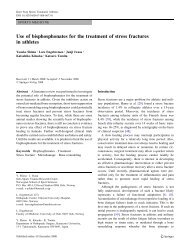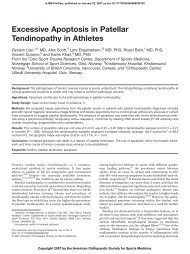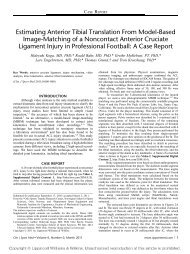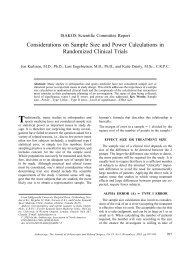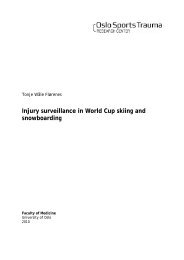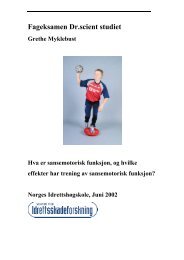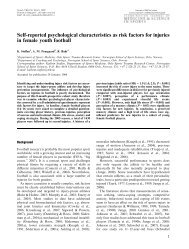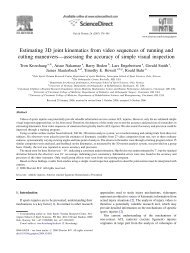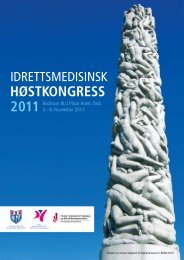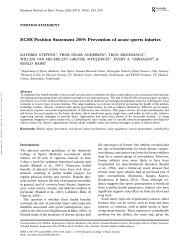The Anatomy of the Medial Part of the Knee
The Anatomy of the Medial Part of the Knee
The Anatomy of the Medial Part of the Knee
Create successful ePaper yourself
Turn your PDF publications into a flip-book with our unique Google optimized e-Paper software.
2000<br />
COPYRIGHT © 2007 BY THE JOURNAL OF BONE AND JOINT SURGERY, INCORPORATED<br />
<strong>The</strong> <strong>Anatomy</strong> <strong>of</strong> <strong>the</strong> <strong>Medial</strong> <strong>Part</strong> <strong>of</strong> <strong>the</strong> <strong>Knee</strong><br />
By Robert F. LaPrade, MD, PhD, Anders Hauge Engebretsen, Medical Student,<br />
Thuan V. Ly, MD, Steinar Johansen, MD, Fred A. Wentorf, MS, and Lars Engebretsen, MD, PhD<br />
Investigation performed at <strong>the</strong> University <strong>of</strong> Minnesota, Minneapolis, Minnesota<br />
Background: While <strong>the</strong> anatomy <strong>of</strong> <strong>the</strong> medial part <strong>of</strong> <strong>the</strong> knee has been described qualitatively, quantitative descriptions<br />
<strong>of</strong> <strong>the</strong> attachment sites <strong>of</strong> <strong>the</strong> main medial knee structures have not been reported. <strong>The</strong> purpose <strong>of</strong> <strong>the</strong><br />
present study was to verify <strong>the</strong> qualitative anatomy <strong>of</strong> medial knee structures and to perform a quantitative evaluation<br />
<strong>of</strong> <strong>the</strong>ir anatomic attachment sites as well as <strong>the</strong>ir relationships to pertinent osseous landmarks.<br />
Methods: Dissections were performed and measurements were made for eight nonpaired fresh-frozen cadaveric<br />
knees with use <strong>of</strong> an electromagnetic three-dimensional tracking sensor system.<br />
Results: In addition to <strong>the</strong> medial epicondyle and <strong>the</strong> adductor tubercle, a third osseous prominence, <strong>the</strong> gastrocnemius<br />
tubercle, which corresponded to <strong>the</strong> attachment site <strong>of</strong> <strong>the</strong> medial gastrocnemius tendon, was identified. <strong>The</strong><br />
average length <strong>of</strong> <strong>the</strong> superficial medial (tibial) collateral ligament was 94.8 mm. <strong>The</strong> superficial medial collateral ligament<br />
femoral attachment was 3.2 mm proximal and 4.8 mm posterior to <strong>the</strong> medial epicondyle. <strong>The</strong> superficial medial<br />
collateral ligament had two separate attachments on <strong>the</strong> tibia. <strong>The</strong> distal attachment <strong>of</strong> <strong>the</strong> superficial medial<br />
collateral ligament on <strong>the</strong> tibia was 61.2 mm distal to <strong>the</strong> knee joint. <strong>The</strong> deep medial collateral ligament consisted<br />
<strong>of</strong> menisc<strong>of</strong>emoral and meniscotibial portions. <strong>The</strong> posterior oblique ligament femoral attachment was 7.7 mm distal<br />
and 6.4 mm posterior to <strong>the</strong> adductor tubercle and 1.4 mm distal and 2.9 mm anterior to <strong>the</strong> gastrocnemius tubercle.<br />
<strong>The</strong> medial patell<strong>of</strong>emoral ligament attachment on <strong>the</strong> femur was 1.9 mm anterior and 3.8 mm distal to <strong>the</strong> adductor<br />
tubercle.<br />
Conclusions: <strong>The</strong> medial knee ligament structures have a consistent attachment pattern.<br />
Clinical Relevance: Identification <strong>of</strong> <strong>the</strong> gastrocnemius tubercle and <strong>the</strong> quantitative relationships presented here<br />
will be useful in <strong>the</strong> study <strong>of</strong> anatomic repairs and reconstructions <strong>of</strong> complex ligamentous injuries that involve <strong>the</strong><br />
medial knee structures.<br />
While <strong>the</strong> medial collateral ligament is <strong>the</strong> most frequently<br />
injured ligament in <strong>the</strong> knee 1-4 , and while a<br />
better understanding <strong>of</strong> its functional anatomy,<br />
biomechanics, and healing has been obtained over <strong>the</strong> past<br />
twenty years 5-9 , we have found that its anatomy has only been<br />
described qualitatively, and <strong>the</strong>re is controversy about descriptions<br />
<strong>of</strong> some aspects <strong>of</strong> its anatomy that have been contradictory<br />
or incomplete 2,6,10-15 . <strong>The</strong> medial ligament complex <strong>of</strong><br />
<strong>the</strong> knee includes one large ligament and a series <strong>of</strong> capsular<br />
thickenings and tendinous attachments. <strong>The</strong> superficial medial<br />
collateral ligament is commonly called <strong>the</strong> tibial collateral<br />
ligament, whereas <strong>the</strong> deep medial collateral ligament is also<br />
called <strong>the</strong> mid-third medial capsular ligament 10,16 . <strong>The</strong> capsular<br />
attachments from <strong>the</strong> main common tendon <strong>of</strong> <strong>the</strong><br />
semimembranosus have been called <strong>the</strong> posterior oblique<br />
ligament 5,17-20 . However, <strong>the</strong>re appears to be controversy about<br />
whe<strong>the</strong>r <strong>the</strong> posterior oblique ligament is a distinct structure<br />
or if it is a portion <strong>of</strong> <strong>the</strong> superficial medial collateral ligament,<br />
termed <strong>the</strong> oblique fibers <strong>of</strong> <strong>the</strong> superficial medial collateral<br />
ligament 2,10,13-17 .<br />
An extensive literature search revealed that, while <strong>the</strong>re<br />
are many qualitative descriptions <strong>of</strong> <strong>the</strong> anatomy <strong>of</strong> <strong>the</strong> medial<br />
part <strong>of</strong> <strong>the</strong> knee 2,5,6,10,13-15,21 , <strong>the</strong>re are no specific quantitative<br />
descriptions <strong>of</strong> <strong>the</strong> medial knee structures. Many <strong>of</strong> <strong>the</strong>se<br />
Disclosure: In support <strong>of</strong> <strong>the</strong>ir research for or preparation <strong>of</strong> this work, one or more <strong>of</strong> <strong>the</strong> authors received, in any one year, outside funding or<br />
grants in excess <strong>of</strong> $10,000 from Health East, Norway, and <strong>the</strong> Norwegian Research Council (grant #42692) and <strong>the</strong> Sports Medicine Research<br />
Fund <strong>of</strong> <strong>the</strong> Minnesota Medical Foundation. Nei<strong>the</strong>r <strong>the</strong>y nor a member <strong>of</strong> <strong>the</strong>ir immediate families received payments or o<strong>the</strong>r benefits or a commitment<br />
or agreement to provide such benefits from a commercial entity. No commercial entity paid or directed, or agreed to pay or direct, any benefits<br />
to any research fund, foundation, division, center, clinical practice, or o<strong>the</strong>r charitable or nonpr<strong>of</strong>it organization with which <strong>the</strong> authors, or a member<br />
<strong>of</strong> <strong>the</strong>ir immediate families, are affiliated or associated.<br />
J Bone Joint Surg Am. 2007;89:2000-10 • doi:10.2106/JBJS.F.01176



